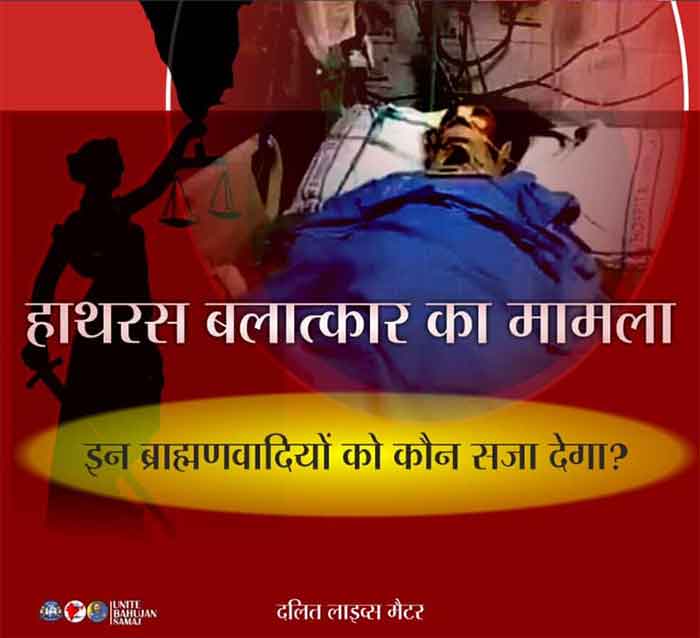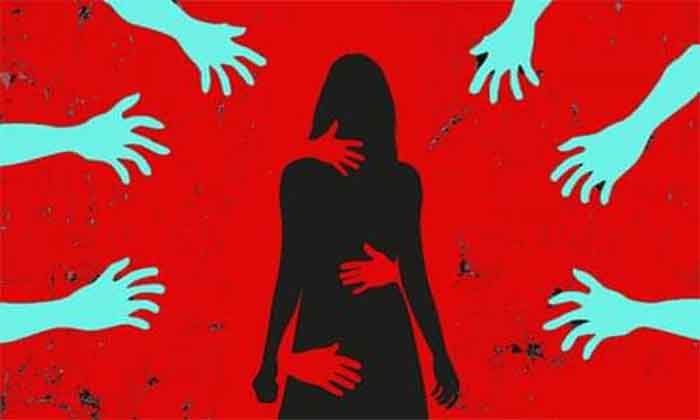
The horrifically brutal and inhuman act of torture and rape perpetrated by Thakur men on a young Dalit woman in Haathras, Uttar Pradesh, tears at the soul and claws the conscience. It provokes violent thoughts and words and makes it impossible to not imagine a proportional response of the same barbaric extent as the ultimate self-defensive justice. This feeling is aggravated further because the structure of social and political power is such that it only categorizes counter-mobilization, assertion, propaganda, and organization of the suppressed as ‘violence’ while continuing with impunity its own. Inciting violence is ironically the foremost phony charge these days laid upon those who question existing status quos of caste, communal, and gender relations and lead others to do the same.
https://twitter.com/TanushreePande/status/1311054885970821121
The fact that pauperization, malnourishment, disproportional imprisonment, lack of basic sanitary facilities, and a whole host of interlocked injustices continue to afflict large masses of a country allegedly blazing forward on the path of ‘development’ and modernity is not spoken of as violence. When atrocities such as the one in Haathras become impossible to ignore, savarna interests across the limited spectrum of their politics unite in downplaying or denying what they term the “caste angle”. Rather than claiming her as a daughter to whom ‘we’ owed protection, it would be more useful for influential savarnas to limit the scope of their address to their caste-fellows, thereby focusing the message where it needs to go. How often do we consider Scheduled Caste women as daughters when it comes to marriages or equal opportunities in schools, colleges, and workplaces? Why is it that our family circles, no matter how extended, only ever include certain names? Are the more ‘liberal’, mostly anglophile among them willing to raise conversations about caste at home? Savarna men like me must introspect on how casually we, or those in our circles, use misogynistic language not just as threats and cusses but also as jokes and sarcasm. We must be conscious of how we degrade women with dark skin tones, and those who dress, speak, and earn their living in ways that we think deserves contempt. It is time to acknowledge that there is a festering casteism underlying our sophisticated lifestyles in urban spaces, and our language, thoughts, and behaviours are influenced by that. We may like to think that our spatial distance from the villages means we have ‘moved on’, and that things like these are done by uneducated criminal elements who cannot “control themselves”.
This is an evasion. Our lives within our own households reflect a gentrified version of the idea that respectability and honor depend on the girls and women of the family observing certain ‘limits’. We inherently want our sisters and mothers to be differentiated from the ‘other’ kind of women who are not so protected and valuable. There is a certain expendability and apathy that we have set aside for women who lay bricks and carry loads, those that work in homes, those we see selling loose items on the footpath, etc. We express our frustration if they have more children than we think they should. This sense of superiority goes beyond a difference of rich and poor. It is fundamentally an issue of caste, and of the historically consistent conditioning of savarna men that they are entitled to the bodies and labour of Dalit women.
The bodies and popular representation of women are a site for the community to draw the lines of domination and hierarchies and assert the relative value and privileges of one over the other. Dalit and Adivasi women are most vulnerable in this regard since they are often made the subjects of the dominant communities acting out (and thus reproducing) their sense of ownership and punitive discipline. The rape case in Unnao was also about the local MLA asserting his murderous dominance over the entire family of the victim. False narratives of Hindus’ oppression by Muslims always center their usurpation of ‘our’ women. The deplorable ‘love jihad’ vigilantes and the hooligans opposing a movie on the grounds of hurting Rajput sentiments by depicting ‘their’ princess romancing a Muslim conqueror are actualizations of this attitude. Speaking of the Kilvemeni massacre of Dalits in Tamil Nadu in the year 1968, Anand Teltumbde writes: “16 women and 23 children were among those killed, compared to five men. The sexual assault of women being the most effective way of ‘teaching them a lesson’ in the patriarchal paradigm, Dalit women became the deliberate targets of rape by upper-caste men. It is not an accident that incidents of rape of Dalit women far exceed that of murders” (emphasis added).
Today also marks the fourteenth anniversary of the Khairlanji rape and murders in Maharashtra, when the entire village descended on a Dalit family in a show of savage barbarism. The aim was to punish them for growing beyond their assigned social status. Again, the rape of the women and their public humiliation was integral to the intended ‘lesson’ of the attack. Teltumbde notes that as assertion and mobility of Scheduled Caste communities has become visible (though it is by no means just or adequate), the atrocities of today’s India are committed as an act of spite and is provoked by resentment at a loss of a right previously considered natural. The contradictions of modernity in India are such that upper-caste superiority can no longer be formally proclaimed, and yet is desired to be practiced and acknowledged. This contributes to the intensity and brutality of the violence characterizing modern caste atrocities and explains why it is often well-planned and carefully executed. The Khairlanji murder was ultimately never acknowledged as a caste atrocity by the judiciary, and the lone surviving father of the tragically destroyed family was thrown a job as a security guard. Similar efforts are already afoot with the plastic indignation of savarnas that this issue is being allegedly falsified as one of caste. The control, domination, and pathological sadism based on ownership and degradation of Dalit women’s bodies bursts out in shameful incidents of inhumanity, but it is omnipresent in everyday life as well. The peace we often find in villages is simmering with resignation and a sense of injustice, as well a hawkish gaze of the dominant castes for the safety of their topmost perch in society. It is tense with aspirations and fear.
Villages may seem unrelated to us, as we consider ourselves forward and as belonging to digital spaces, but here too, our real-life comforts and acquired literacy give us the ability to harass assertive and dissenting women from Dalit and other marginalized communities. Cheap and filthy comments on Dalit women are common in online spaces. Pages such as Based Brahman Memes continue to be active despite posting vitriolic hatred and sharing pictures and screenshots of anti-Brahmanical comments made by women by stealing from their personal profile, with the obvious intent of instigating harassment and ridicule. Liberal and Left pages beat down Dalit-specific discourses in their own ways, using the bogey of ‘law and order’ or ‘identity politics’.
In such a context, the state invariably springs to the defense of its dominant members, for whose interests and preservation it is empowered with a monopoly on all violence. We saw how the distraught family from Haathras was whisked away from the hospital where their daughter died, and how a posse of police and paramilitary met citizens assembling to protest. The aftermath of any caste atrocity in a village is the immediate deployment of police to contain the possibility of counter mobilization and defensive strikes of the Dalits. The village agrees to itself to erase whatever happened and enforces a sense of normalcy as another form of coercion on an already besieged people. Dalit women are seen as ‘available’ to upper-caste men, and the state becomes a “tormenter rather than a protector, as seen from the highly prejudicial conduct of the police and the judiciary in the plethora of cases of atrocities against Dalit women”. (Teltumbde).
As the wronged victim breathed her last today there was an outpouring of emotions and opinions on social media and protests on the ground at Safdarjung Hospital in Delhi. Distressing reports were shared of how she was treated when she was first brought to the police. She was hardly given any care at all, let alone that appropriate for her condition. Her parents had to struggle against a cruel medical administration just to have doctors visit her. Now, it is being declared that the postmortem does not prove a rape! Can there be something more shameful than this? Television media, which would happily mention full names of Muslims to paint a target on the backs of an entire people, refused to mention the last names, i.e. caste names of the perpetrators. There is already organized support from them from savarnas apart from those operating the state machinery. At this point, it is not blindness but complicity that prevents savarna men from calling out their central position in this ongoing nightmare for Dalit girls and women. We have to discard our sense of moral difference from ‘those guys’ and intervene when we hear degrading language or any assertion of our caste-based power and privileges. We must learn to listen for this. The remedy has to be systematic and structural but it is not up to us to guide it. We have to discard the delusion of being free of caste. Our behaviors, lifestyles, utterances, and cultural power is the root of much of the misery we observe around us, particularly that endured by Dalit, Bahujan, and Adivasi women. The power of caste has choked the possibilities of restorative identification characterized by humility, remorse, and a united rejection of this system of graded humanity. Our failure to identify with Dalit women is because they are placed farthest from us in the caste and gender hierarchy, but the onus is on us to transcend the distance which is not merely ideological but very much real and concrete. Our emotional and moral sensitivity, and our sense of humanity itself, has been eroded and compromised by the caste system because it offers so much power in return.
In the end, the edifice of things as they are will not endure, and in the words of Karl Marx, “violence is the midwife of every old society pregnant with a new one”. Let us speak up and turn our face against the reactionary violence of fellow savarna society. We savarna men have reaped fruits sown in blood for too long. The least of an apology to that history would be to have an honest conversation on caste.
REFERENCES:
1. Foreword: Dalits, Dalit women and the Indian State by Anand Teltumbde, in Dalit Women: Vanguard of an Alternative Politics in India (2017)
Picture source: https://www.facebook.com/113447536871635/photos/a.114331833449872/205103851039336/
Arjun Banerjee is a first-year Master’s student in Delhi University.
SIGN UP FOR COUNTERCURRENTS DAILY NEWSLETTER















































